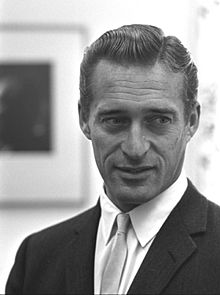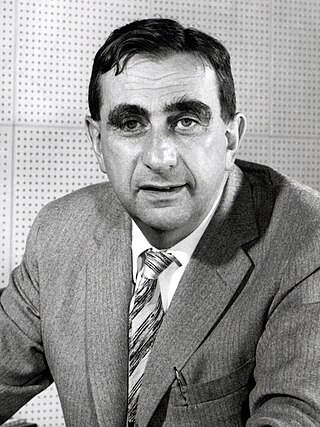
Edward Teller was a Hungarian-American theoretical physicist and chemical engineer who is known colloquially as "the father of the hydrogen bomb" and one of the creators of the Teller–Ulam design.
Lawrence Livermore National Laboratory (LLNL) is a federally funded research and development center in Livermore,California,United States. Originally established in 1952,the laboratory now is sponsored by the United States Department of Energy and administered privately by Lawrence Livermore National Security,LLC.

Ernest Orlando Lawrence was an American nuclear physicist and winner of the Nobel Prize in Physics in 1939 for his invention of the cyclotron. He is known for his work on uranium-isotope separation for the Manhattan Project,as well as for founding the Lawrence Berkeley National Laboratory and the Lawrence Livermore National Laboratory.
A nuclear electromagnetic pulse is a burst of electromagnetic radiation created by a nuclear explosion. The resulting rapidly varying electric and magnetic fields may couple with electrical and electronic systems to produce damaging current and voltage surges. The specific characteristics of a particular nuclear EMP event vary according to a number of factors,the most important of which is the altitude of the detonation.
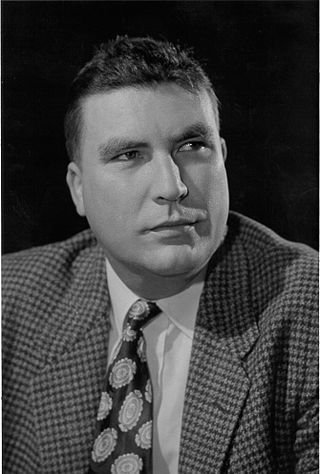
Herbert Frank York was an American nuclear physicist of Mohawk origin. He held numerous research and administrative positions at various United States government and educational institutes.
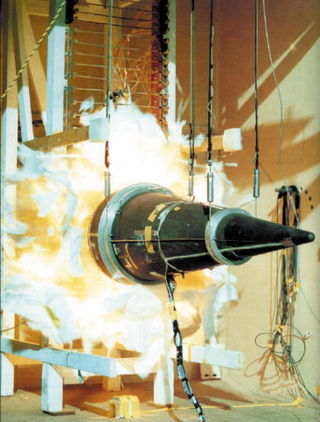
Stockpile stewardship refers to the United States program of reliability testing and maintenance of its nuclear weapons without the use of nuclear testing.

William Robert Graham is an American physicist who was chairman of President Reagan's General Advisory Committee on Arms Control from 1982 to 1985,a deputy administrator and acting administrator of NASA during 1985 and 1986,and director of the White House Office of Science and Technology Policy and concurrently science adviser to President Reagan from 1986 to 1989. He then served as an executive in national security-related companies.

Sidney David Drell was an American theoretical physicist and arms control expert.

Arden Lee Bement Jr. is an American engineer and scientist and has served in executive positions in government,industry and academia.

Michael Anastasio led two national science laboratories during a time of transition. He was the director of the Los Alamos National Laboratory and president of the Los Alamos National Security LLC,the company that operates the laboratory. He is the former director of Lawrence Livermore National Laboratory (LLNL). The University of California Board of Regents appointed Michael R. Anastasio the director of LLNL on June 4,2002. He started on July 1,2002. In 2005 he became the president of the Los Alamos National Security LLC,and became the director of the Los Alamos National Laboratory on June 1,2006. During his directorship at Lawrence Livermore,the laboratory won 25 R&D 100 Awards and maintained its world-class leadership position in high-performance computing and its application to global climate modeling.

Curtis Bruce Tarter is an American theoretical physicist. He was the director of the Lawrence Livermore National Laboratory from 1994 to 2002. As director emeritus he recently published the first comprehensive history of the laboratory.
John Stuart Foster was a Canadian physicist.

John C. Browne is an American physicist.

Edward Moses is an American physicist and is the former president of the Giant Magellan Telescope Organization. He is a past principal associate director for the National Ignition Facility &Photon Science Directorate,where he led the California-based NIF,the largest experimental science facility in the US and the world's most energetic laser,that hopes to demonstrate the first feasible example of usable nuclear fusion.

Conrad Lee Longmire was an American theoretical physicist who was best known as the discoverer of the mechanism behind high-altitude electromagnetic pulse.

Harold Melvin Agnew was an American physicist,best known for having flown as a scientific observer on the Hiroshima bombing mission and,later,as the third director of the Los Alamos National Laboratory.
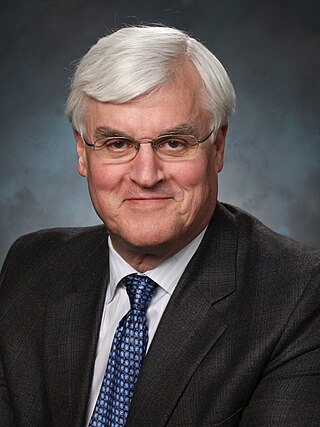
Penrose "Parney" C. Albright is an American physicist known for his work with the U.S. Government,think tanks and National Laboratories,and government contractors. Since November 1,2014,he has been the president and CEO of HRL Laboratories,a research firm jointly owned by Boeing and General Motors. Until December 2013 he served as the director of Lawrence Livermore National Laboratory,and,in 2014,he served as a senior advisor in the Office of the Director of National Intelligence.

Stephen Joseph Lukasik was an American physicist who served in multiple high-level defense and scientific related positions for advancing the technologies and techniques for national defense and the detection and control of diverse types of weapons of mass destruction,especially nuclear devices. He was the second longest serving Director of DARPA - the Defense Advanced Research Projects Agency –during which numerous new technologies including packet and internet protocols were developed. He was also the first chief scientist of the Federal Communications Commission where he created its Office of Science and Technology and which facilitated the commercial deployment of new technology that included spread spectrum technology.

Kimberly Susan Budil is an American physicist who is the 13th and current director of Lawrence Livermore National Laboratory,making her the first woman to hold this position. She completed her bachelor's degree in physics from the University of Illinois Chicago,and her master's and doctorate in applied science from the University of California,Davis. She collaborated with Nobel laureate Donna Strickland,and made significant contributions to the field of high-power,ultra-fast lasers. Starting her career at Lawrence Livermore National Laboratory in 1987,she held various roles across government departments,including the Department of Energy and the Department of Defense. In 2014,she managed relations between the University of California's campuses and the three Department of Energy labs it manages. Budil,who was made a fellow of the American Physical Society in 2019,has also been a prominent advocate for women in science.
Miriam E. John is an American engineer who is a policy advisor and former vice president of Sandia National Laboratories. She is an expert in nuclear weapons and chemical defence. In 2022,she was awarded the Lawrence Livermore National Laboratory John S. Foster,Jr. Medal and was elected Fellow of the National Academy of Engineering.
